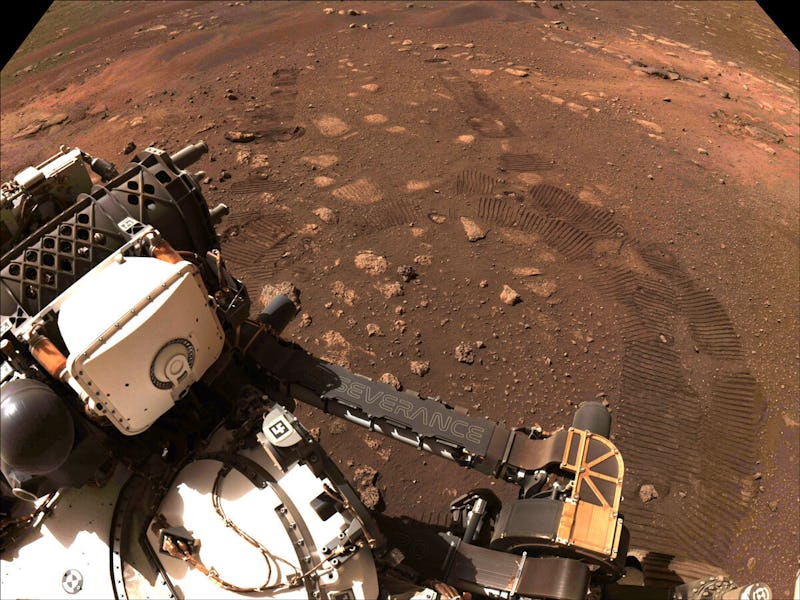The NASA Mars rover collects something historic
This tiny piece of rock will help solve one of the biggest mysteries of the universe.

If you’re in a place where no human has been before, you simply must bring back a souvenir.
NASA’s Mars Perseverance rover has collected its first sample — a core of dirt a little thicker than a pencil — from the red planet and stowed it away for a future return mission to Earth. It could help answer the biggest question in the cosmos: Is there more life in the universe?
But first, the samples need to make the 33.9 million-mile journey back to Earth. The trip back involves two separate missions, one to land, retrieve and propel the samples into Mars orbit. The second mission involves catching the samples and send them on their way through space.
On Monday, NASA confirmed that the Perseverance rover collected its first sample of Martian rock. (The sample was taken from the core of familiar Jezero Crater.)
“For all of NASA science, this is truly a historic moment,” Thomas Zurbuchen, associate administrator for science at NASA Headquarters in Washington, said in a statement.
“Just as the Apollo Moon missions demonstrated the enduring scientific value of returning samples from other worlds for analysis here on our planet, we will be doing the same with the samples Perseverance collects as part of our Mars Sample Return program.
The sample was stored in an airtight titanium sample tube inside the rover’s belly.
The first Martian sample was stored in sample tube number 266, seen here in this image taken by the rover’s Sampling and Caching System Camera.
How the Mars rover collects soil samples
This was the rover’s second attempt at collecting a piece of the Red Planet, but the first successful one. (It failed in its first attempt in early August; the rover pulverized the sample into small bits.)
Perseverance collects the samples using a drill attached to the robot's arm.
The samples move through the robot's belly and into the Adaptive Caching Assembly System, where they are assessed and processed.
The assembly system contains seven motors and more than 3,000 parts, including the Sample Handling Arm used by the rover to hold sample tubes. But on its first try, the robot’s arm came up empty.
The second try began on September 1, and was later confirmed on Monday after Perseverance moved sample tube number 266 into its interior to measure and image the rock core. The image showed the tiny Martian rock core carefully tucked away in its assigned tube.
How Mars soil samples return to Earth
Once it has collected its samples, Perseverance will leave them behind on Mars for that pickup mission planned for sometime in the 2030s.
NASA is planning on sending a Sample Retrieval Lander mission that will land a platform near the site where Perseverance stowed the sample tubes. Once the platform touches down on Mars, a small rover designed by the European Space Agency (ESA) will roll out and grab the samples.
The rover will then collect all the sample tubes into a single large canister on the platform, known as the Mars Ascent Vehicle. This vehicle will then liftoff from Mars, carrying the canister into Mars orbit.
In Mars’ orbit, another mission will be waiting to catch the canister.
ESA’s Earth Return Orbiter will be timed to catch the basketball-sized canister in the void of space. Once they’re in safe hands, the samples will be sealed in a biocontainment system so that they don’t contaminate Earth with any unknown material from Mars (think of the plot of any sci-fi alien movie).
The orbiter will travel back to Earth, and drop off the canister so that it can be retrieved on Earth.
This is Brazil. But Mars might’ve been a wet planet at one time, too.
What the Mars samples could teach us about aliens
Mars may be a dry desolate world today, but scientists believe that the Red Planet may have once been a warm, wet world that could have potentially hosted life.
Space agencies have sent missions to Mars in the past, but they’ve never gotten their hands on a piece of Mars. In order to figure out Mars’ potentially habitable history, scientists want to analyze samples from the planet in a lab to look for signs of ancient microbial life buried in the rocks and sediments.
Perseverance is carrying 43 titanium sample tubes, and is supposed to collect at least 20 samples from Mars during its 687 Earth day mission on Mars.
This article was originally published on